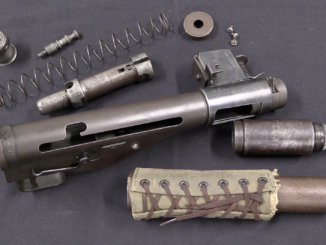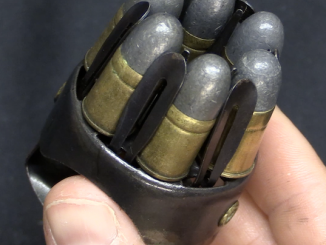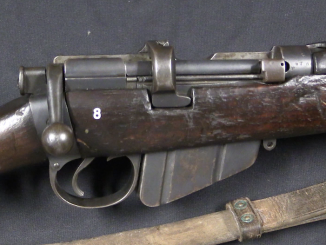When the SMLE was adopted by the British, it was to be the new universal rifle for all branches of service, including the Royal Navy. This suited the Navy just fine; they like the features of the new design. However, the Army quickly moved to update their rifles for the new MkVII Spitzer ammunition, and this was an issue. The Navy still had substantial stockpiles of the older round-nose MkVI cartridge, and did not go through it nearly as quickly as the Army. The Navy did not want to simply throw out their ammunition, but the differences in trajectory between the two types of ammunition was substantial. So the Navy opted to adopt its own unique rifle variation, the MkI**. This in effect was the new Army pattern rifle, but with the rear sight still calibrated for the trajectory of MkVI ammunition.
This pattern was first adopted in 1908, using rifles with the then-standard split charger guide. When the fixed charger bridge was adopted, the Navy (which still had plenty of MkVI ammunition) chose to update its MkI** rifles to fixed charger bridges, without making any change to their designation. Once they finally ran out of the older ammunition during World War One, the rifles were updated once again to what was then the standard MkI*** pattern. As a result, intact MkI** rifles – especially ones with the split charger guide – are extremely rare to find today. Many thanks to the owner of these two specimens for giving me access to share them with you!




During WWI the Royal Navy fielded what were known as Royal Navy Divisions as infantry on the front line. This came about because many men volunteered for the navy, which ended up with more men than it needed, so the surplus men were used instead as infantry at Gallipoli and the Western Front. But they were still sailors under naval command, not soldiers.
I wonder if the Royal Naval Divisions were equipped with these Mk3** rifles, or the more common Mk3***? It would have been a bit awkward to have had a separate ammunition supply for the RNDs, but it may have happened.
In reality, given the range at which battles were fought in WWI, the sighting differences between the two marks may not have been of much practical importance. A rifle zeroed for 200 yards would have been good enough for most soldiers.
Wow, I bet the sailors who had to fight as infantry were not happy. Especially in the Trenches.
I believe morale in the Royal naval Divisions was good. Since the men were sailors, they kept to naval regulations, so were allowed to have beards, and of course the daily rum ration. As members of the senior service, they considered themselves a cut above the army,
When conscription was introduced in 1916, men could be sent to the service which needed them most, which was obviously the army, so the Royal Naval Divisions dwindled after that. But they had served well, and had pioneered weapons such as the Rolls-Royce armoured car. Their enthusiastic leader was the First Lord of the Admiralty, a fellow by the name of Winston Churchill. I wonder whatever happened to him?
I have a 1916 MKIII SMLE upgraded to MK III* which is marked RM for issue to Royal Marines who served as infantry on the Western Front and who fought as part of the 1st Brigade Royal Naval Division.
Logistically This would make sense being part of land rather than sea operations.
The US Navy finally adopted the new heavy bbl M-16 for their small ground forces & boarding parties – but not the M-16A2. The Navy has ships full of ammo, so there was no need for the 3-round burst limiter; ergo, the M-16A3 had the full auto switch w/ the 800m rear sight. Then the Marines got the M-16A4 w/ the Picatinny rail instead of the carry handle/fixed rear sight. So the Navy switched to the Picatinny rail uppers – w/o changing the designation of M-16A3.
Plenty of the safe/semi/full flat-top lowers in Navy armories today have M16A3 struck through and M4A1 stamped next to it. In my (limited) experience, it’s about an even split between FN-built former M16A3 lowers and genuine M4A1 with the prancing pony.
I believe that during WWI the RN had to hand in their SMLEs to the army and were given Arisakas instead. What did the army do with the MKI** rifles which used MkVI ammunition? Did the army convert them, or did they just issue MkVI ammunition for them?
I lived through a similar ammo swap-out from the 1980’s to my retirement in 2010–the M193 cartridge and the M16A1 Rifle were replaced by the M855 cartridge and M16A2 Rifle during the 1980s but not all at once. It didn’t happen overnight and some units still had M16A1 rifles in their arms room into the 21st Century–though stocks of US M193 had been exhausted by then. Law enforcement used 5.56mm rifles with 1 turn in 12 inches rifling twist longer because their patrol rifles were often private-purchase/agency approved and there wasn’t money to replace cop heavy artillery. Some treaty nations used the older M193 cartridge and rifles with 1 in 12 twist longer than the USA and so using old ammo in new guns or using new ammo in old guns required addressing during rifle marksmanship trainig.
During the 1990’s the USA switched from the M193 cartridge (5.56mm) to the M855 cartridge (NATO SS-109) and had substantial stocks of the older 55 grain M193. Many NATO and SEATO allies used the older M193 (55 grain) and so FM 23-9 had to provide instructions for using the M193 in the new M16A2 rifles. The newer, heavier 62-grain bullet of the M855 was designed with enhanced long-range penetration in mind so that the cartridge could better fill the Squad Automatic Weapon role when fired from the M249 light machine gun–but the composite M855 projectile was longer than the M193 projectile and required a faster rifling twist. The original 5.56mm M16 had a 1 in 14 inch rifling twist but that proved insufficient to stabilize the M196 tracer projectile in Arctic testing–so the M16 and M16A1 were given a faster 1 in 12 rifling twist. The M16A2 Rifle, M4 Carbine, and M249 Squad Automatic Weapon were made with a 1 in 7 rifling twist to stabilize the longer M856 Tracer projectile under Arctic conditions.
https://nationalinterest.org/blog/reboot/battle-bullets-ss109-vs-556mm-who-wins-174600
Both M193 ammunition and the M16A1 served alongside M885 ammunition and M16A2 rifles. Some units received M855 Ball ammunition for their M16A2 rifles after stocks of M855 were exhausted until the older rifles were replaced. Due to the large stocks of M193 world-wide (often used by allies) there were instructions on using the M16A2 with the older ammo–and mostly it was adjusting zero and accepting that there was going to be significant trajectory variations from M855 at distances beyond 300 meters. As many units (National Guard, service and support, Air Force) still had the M16A1, instructions were in place for using the newer M855 in the M16A1 (1 in 12 rifling twist) that included “emergency use only” and different Point of Impact and a 100 meter limit due to marginally-stabilized 62 grain projectiles.
https://www.bevfitchett.us/rifle-marksmanship-m16a1/ballistics.html#:~:text=Although%20firing%20the%20M855%20cartridge%20in%20the%20M16A1,A%20M16A1%20M855%20%28100%20Yards%29%20M855%20%28300%20Yards%29
History repeated–the Royal Navy adopted a special edition of the SMLE to use their ammo stocks. The USA issued instructions to permit using M193 ammo in the M16A2 and using M855 ammo in the M16A1.
The Air Force converted M-16s and AR-15s to “M16-A2” during the 1990s because M193 wasn’t available from the Army. Barrels, fire control groups, and furniture on old receivers. But the markings still said M-16 or AR-15.
Usually, the use of cartridges with different ballistics is not a critical issue.
It’s just that the soldiers are handed out tables of amendments, which indicate which setting of the old sight corresponds to that required for new bullets.
Except when it is. For example SS 109(62gr) will start to keyhole out past 100 meters or so out of a 1in12 twist barrel.
In “normal” combat situations, this makes absolutely no difference.
A normal soldier should understand the difference between different ammunition. And aim accordingly.
And it can even benefit from it.
For example, many users of Galil or old M16s specifically put 2-3 “machine-gun” cartridges first, as giving the best destructive effect in case of close contact.